The Historic and Ancient city of Rome was the capital city of the ancient Roman civilization. It was located near the west coast of central Italy. Today, Rome is the capital of the country of Italy. The city started out small, but grew as the Roman empire grew.
In historiography, ancient Rome describes Roman civilization from the founding of the Italian city of Rome in the 8th century BCE to the collapse of the Western Roman Empire in the 5th century CE, in turn encompassing the Roman Kingdom (753–509 BCE), Roman Republic (509–27 BCE) and Roman Empire (27 BC–476 CE) until the fall of the western empire.
Founded in 754 BCE, ancient Rome emerged from humble beginnings to become a dominant civilization that profoundly shaped Western history. During the Roman Kingdom, it thrived as a monarchy until 509 BCE when the Roman Republic was established, bringing with it a system of representative government. The Republic expanded its influence through military conquests, exemplified by the Punic Wars with Carthage. In 27 BCE, the Republic gave way to the Roman Empire under Augustus, ushering in a period of imperial rule and remarkable growth. The Pax Romana, a time of relative peace, facilitated economic prosperity, extensive infrastructure development, and cultural achievements.
However, internal strife, economic challenges, and external pressures gradually weakened the Western Roman Empire. In 476 CE, the last Roman emperor, Romulus Augustulus, was deposed by the Germanic chieftain Odoacer, marking the symbolic end of ancient Rome's Western Empire, while the Eastern Byzantine Empire continued to flourish until the fall of Constantinople in 1453 CE.
Explore History of Ancient Rome
Timeline of Ancient Rome
Interactive Map of the Roman Forum
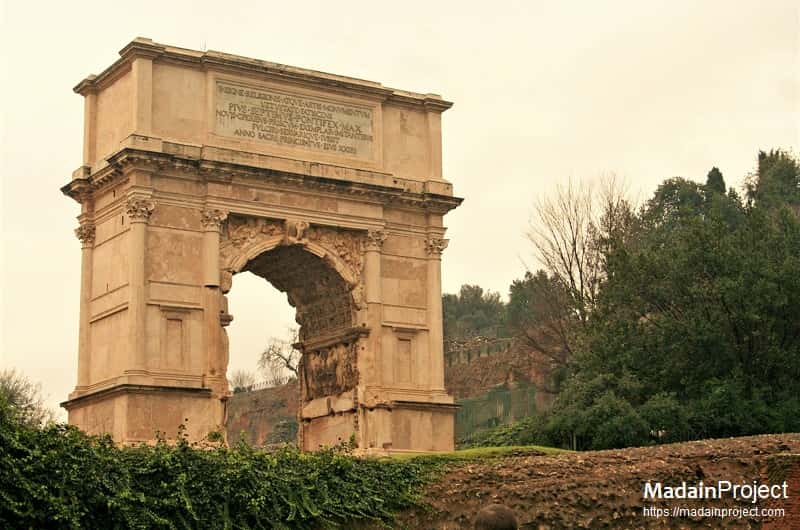
The Arch of Titus, an iconic ancient Roman monument, celebrates Emperor Titus's victories and is a symbol of Rome's rich history and enduring legacy. Read more

The Saint Peter's Complex, a masterpiece of Renaissance architecture, in Vatican City is an awe-inspiring testament to the convergence of art, faith, and history. Read more

This historic area of Roman Forum served as the political, religious, and commercial center of the Roman Republic and later the Roman Empire. Read more
For many years, the Roman Forum served as the core of the ancient city of Rome, where people could find and admire civic, legal, and social buildings and monuments. Starting from the mid-first century BCE, starting with Caesar and ending with emperor Trajan, new public spaces, called fora, were built. These fora, built by Roman emperors during the Roman imperial period, were used for important public events and was designed to use monumental art and architecture to convey ideological messages.

Founded in the fourth century BCE and located just a short distance from Rome, it is an extraordinary archaeological site that provides a vivid glimpse into the daily life, commerce, and culture of ancient Rome. Read more

Believed to be the site where the mythical she-wolf, Lupa, nursed and raised the twin brothers, Romulus and Remus, is one of the most iconic and historically significant of the seven hills of Rome. Read more

The Baths of Caracalla (Terme di Caracalla) are renowned for their sheer scale and architectural sophistication, offering a window into the opulent leisure activities of ancient Roman society. Read more
The park is located in the southern part of Rome, near the Appian Way, one of the most important ancient roads in the world. The Caffarella Valley, which gives the park its name, is a pastoral landscape that has been cultivated since ancient times. The valley was once a fertile agricultural area, and many of the traditional farming practices are still in use today. One of the main attractions in the park is the Ninfeo di Egeria, an ancient structure that was once part of a sanctuary dedicated to the goddess Egeria.
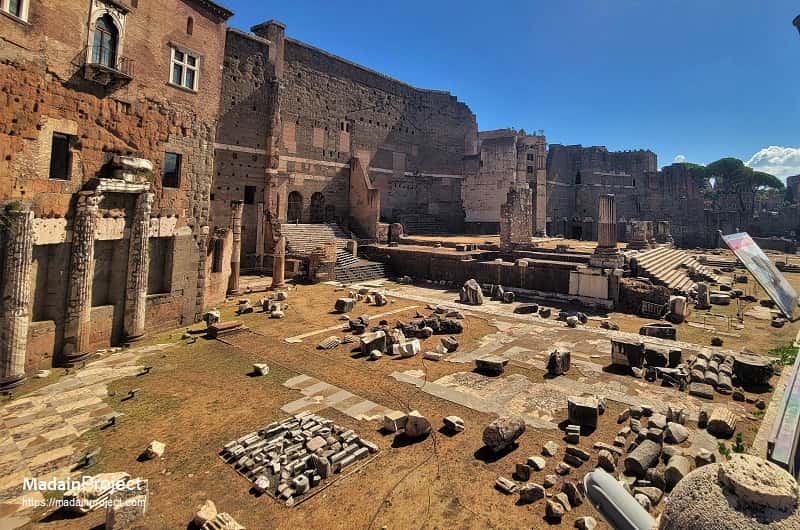
The Forum of Augustus (Foro di Augusto) was commissioned by Emperor Augustus as a means of commemorating his victory over Julius Caesar's assassins, thus securing his rule and the beginning of the Pax Romana. Read more
The Arch of Malborghetto, originally built in the first half of the fourth century, was an ancient Roman quadrifrons arch situated approximately nineteen kilometers to the north of Rome along the via Flaminia. Read more

Trajan's Forum was the last of the Imperial fora to be built, designed by the renowned architect Apollodorus of Damascus. The Forum's location is nestled between the Quirinal and Capitoline Hills. Read more
The construction of Pantheon was initiatied in 27 BCE by Marcus Vipsanius Agrippa, probably as a building of the ordinary Classical temple type rectangular with a gabled roof supported by a colonnade on all sides and then completely rebuilt by emperor Hadrian sometime between 118 and 128 CE, and some alterations were made in the early 3rd century by the emperors Septimius Severus and Caracalla. It was built as Temple dedicated to the pantheon of Roman gods but since 609 CE it was consecrated as a Catholic church.
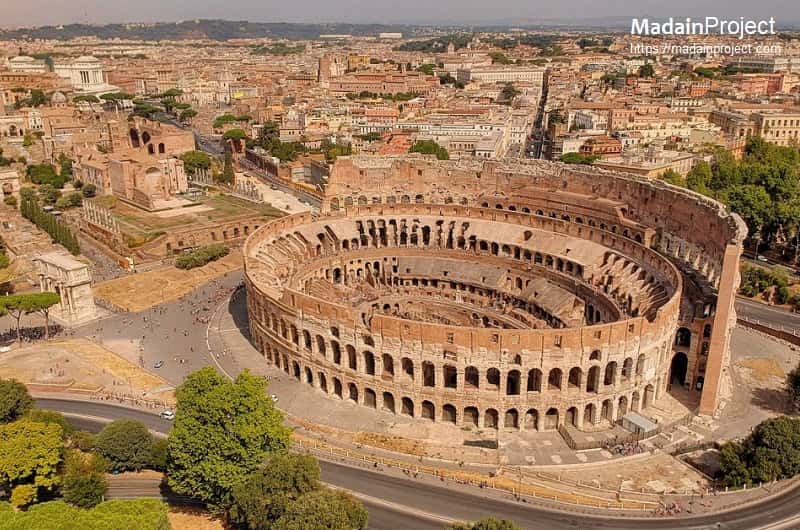
The Colosseum, also known as the Flavian Amphitheatre, constructed over a period of approximately eight years (between 70 to 80 CE), is one of the most iconic and enduring symbols of ancient Rome. Read more

Rising above the Roman Forum and flanked by the Tabularium, the Capitoline Hill, Campidoglio, has played a central role in the city's history, serving as a symbolic and political focal point for over two millennia. Read more

Originally established as an oppidum by the people of the Latial culture, Antium evolved into a formidable stronghold for the Volsci people until the inevitable tide of Roman conquest swept over its storied grounds. Read more
Dedicated in 498 BCE, the Temple of Saturn is the oldest sacred place in Rome, after the Temples of Vesta and Jupiter. It was rebuilt in 42 BCE and again, in the fourth century CE, by the SPQR - Senatus Populusque Romanus (senate and people of Rome), as recorded on the architrave. Because of the link of Saturn with agriculture, the original source of Rome's wealth, the temple was the repository for the State treasury, the Aerarium Populi Roman (from aes, bronze), which was located beneath the stairs under the high podium. It also contained the bronze tablets on which Roman law was inscribed.
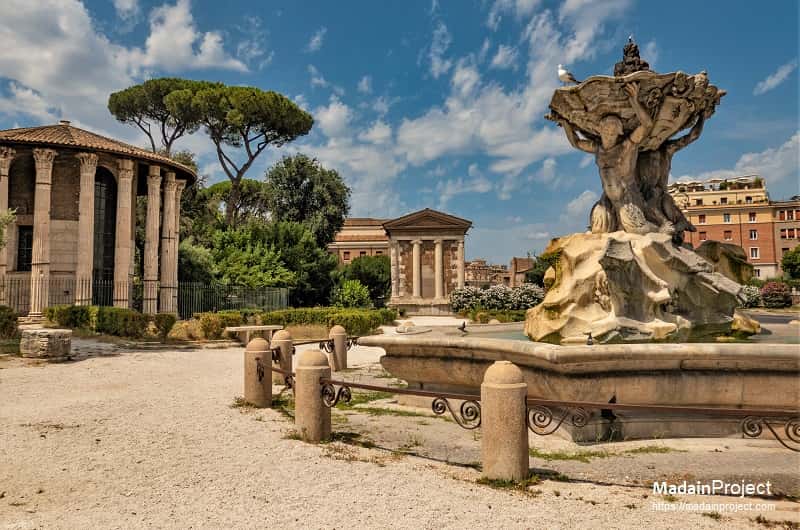
The Foro Boario was an ancient Roman cattle marketplace located in the heart of Rome. It was one of the city's oldest and most important commercial centers and played a significant role in trade and commerce during the Roman Republic and Empire. Read more
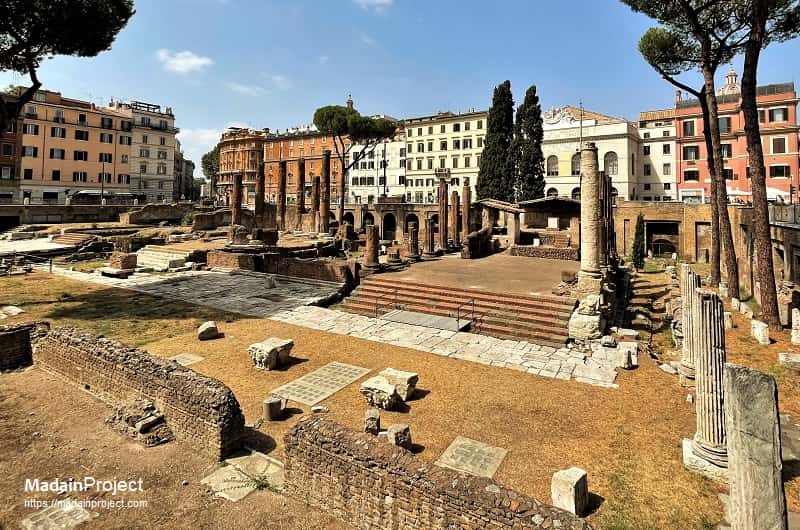
Often referred to simply as Largo Argentina, is an archaeological site located in the historic center of Rome. The archaeological site at Largo Argentina contains the remains of four Roman temples dating from the 3rd to the 1st century BCE. Read more

It is the spiritual and administrative center of the Roman Catholic Church and serves as the residence of the Pope. Vatican City is the spiritual heart of the Catholic Church, home to St. Peter's Basilica, one of the largest and most renowned Christian churches. Read more
The Seven Hills of Rome are a group of seven hills that were the original settlements of the ancient city of Rome. These hills are the Aventine Hill, Caelian Hill, Capitoline Hill, Esquiline Hill, Palatine Hill, Quirinal Hill, and Viminal Hill. Each of these hills has its own unique history, and many famous landmarks and monuments can be found on them. The Capitoline Hill, for example, is home to the Capitoline Museums and the famous Piazza del Campidoglio. The Seven Hills of Rome offer a glimpse into the rich history of the city.

The Forum of Caesar was built by Julius Caesar, one of the most prominent figures in Roman history, around 46 BCE. It was part of his ambitious urban development projects in Rome. The forum served multiple purposes, including political, commercial, and religious functions. Read more

Castel Sant'Angelo was originally commissioned by the Roman Emperor Hadrian as a mausoleum for himself and his family. Construction began in 135 CE, and it served as a tomb for several Roman emperors. In the Middle Ages, Castel Sant'Angelo was converted into a fortress. Read more

The walls, made of large blocks of tuff and concrete, were built to encircle and protect the city of Rome from external threats, particularly from invading barbarian tribes. The construction of the Aurelian Walls began in 271 CE during the reign of the Roman Emperor Aurelian, from whom they derive their name. Read more
The Ara Pacis Augustae, or Altar of Augustan Peace, stands as a constant reminder of Augustus' visionary leadership and the significance of Pax Romana. Erected between years 13 and 9 BCE, this intricately carved white marble altar exemplifies the fusion of art, architecture, and political propaganda. It was commissioned to commemorate Augustus' return to Rome after his military successes in Hispania and Gaul. The marble altar showcases intricate and serpentine reliefs depicting various allegorical and mythological scenes, reflecting Augustus' ideal of social harmony, stability, and cultural prosperity under his rule.

The Forum of Nerva was constructed between 97 and 98 AD during the reign of the Roman Emperor Nerva, who ruled for a brief period. It is one of the smallest and least grand of the Imperial Forums. The forum is located in close proximity to the Roman Forum and is part of a complex that includes the Forum of Augustus and the Forum of Trajan. Read more
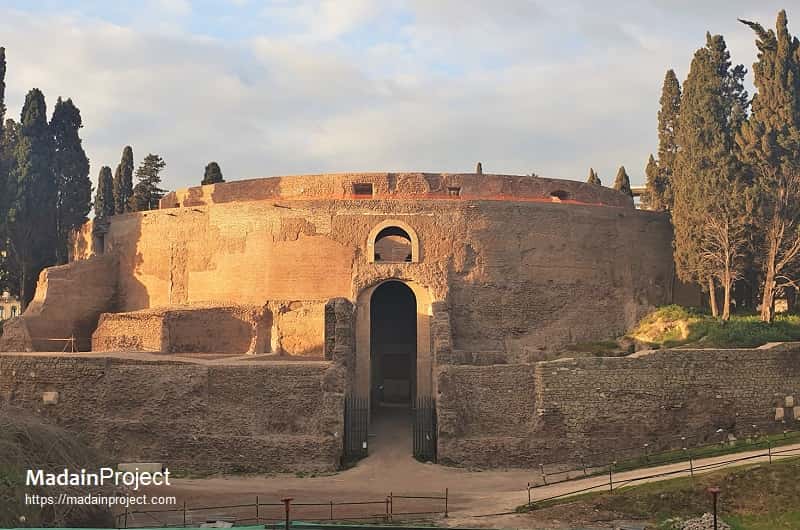
The mausoleum of emperor Augustus was a massive circular structure with several tiers, featuring a central burial chamber where the ashes of Augustus and his family members were interred. The mausoleum held the remains of several emperors and important figures, including Augustus himself, Tiberius, Caligula, and Claudius. Read more

Trajan's Market, situated on the slopes of the Quirinal Hill, was built in the early second century CE during the reign of the Emperor Trajan, after whom it is named. The construction of multi-level and semi-circular complex was part of a larger project that included the construction of Trajan's Forum, Basilica Ulpia and Trajan's Column. Read more
The Res Gestae Divi Augusti, literally meaning "The Deeds of the Divine Augustus," was an autobiographical inscription that offered a unique and intimate glimpse into the life, achievements, and legacy of first Roman Emperor Augustus. The text itself was most likely composed during his lifetime and may have underwent several revisions. The Res Gestae is a testament to Augustus' meticulous efforts to shape his own narrative and secure his place in history. The original version, inscribed in Latin on bronze plaques or columns and positioned at the entrance of Augustus' mausoleum, has been lost to time.

The Museum of the Ara Pacis was designed by architect Richard Meier and opened in 2006 CE. It was constructed to provide a permanent home for the Ara Pacis Augustae, which was commissioned by the Roman Senate to honor Augustus and celebrate the peace brought about by his rule. it was completed in 9 BCE. Read more

The villa was originally built in the second century CE and was owned by the Quintilii brothers, Sextus Quintilius Condianus and Sextus Quintilius Valerius Maximus. The villa complex included luxurious residential quarters, gardens, courtyards, thermal baths, a large ornamental pool, and even a hippodrome for horse racing. Read more
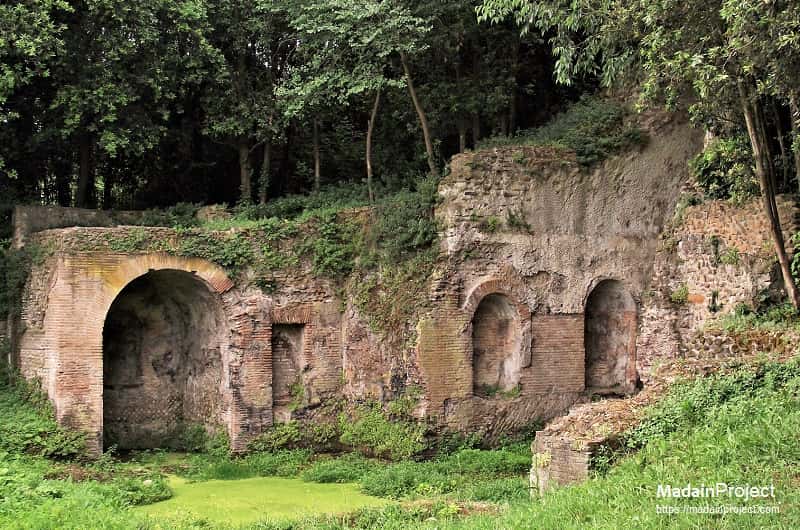
The nymphaeum was built in honor of Egeria, a water nymph from Roman mythology. Egeria was associated with water and fertility, and she was believed to be a divine figure connected to springs and flowing water. It is a somewhat well-preserved structure that served as a sanctuary and a place for religious rituals. Read more
During antiquity the monumental building, covering an area of approximately six thousand square meters, was known as Basilica Nova (the new basilica) was one of the most impressive buildings in the Roman Forum. The construction started during the time of emperor Maxentius (reigned 306-312 CE) and the structure was completed during the reign of emperor Constantine (reigned 306-337 CE). The original design of Maxentian era was somewhat altered during under Constantine when a second porticoed entrance from the Via Sacra was added to the basilica in addition to the original entrance from the south.

The Circus Maximus, situated in a valley between the Palatine and Aventine Hills, was one of Rome's oldest and largest entertainment venues, with its origins dating back to the sixth century BCE. It was initially used for chariot races and other public spectacles. The stadium was an enormous structure, stretching approx. 600m in length and 140m in width. Read more

The Portus Romae served as the principal maritime port of ancient city of Rome during the Imperial period. Portus played a crucial role in the transportation of goods, supplies, and people to and from the city of Rome. Originally, constructed during the reign of Emperor Claudius in 42 CE, Portus underwent subsequent expansions and developments under emperors like Nero and Trajan. Read more
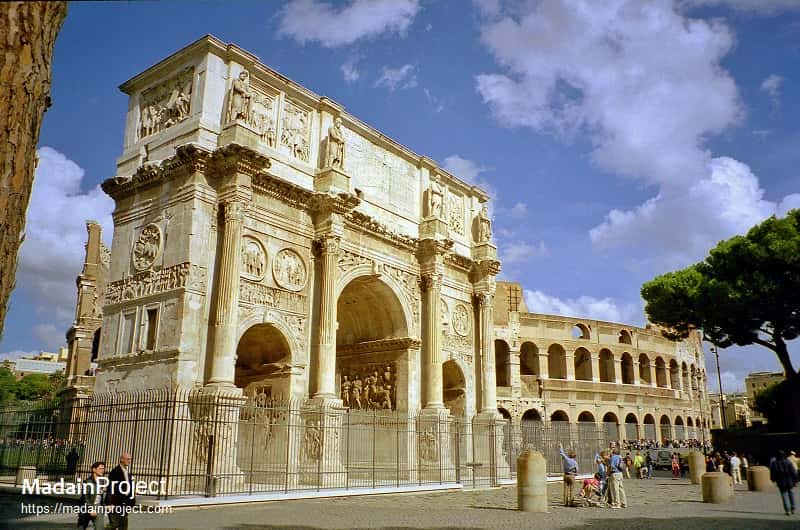
The Arch of Constantine (Arco di Costantino), an awe-inspiring triumphal arch, was erected in 315 CE to commemorate the victory of Emperor Constantine I in the Battle of Milvian Bridge. Many of the decorative sculptures, including statues and reliefs, were taken from earlier imperial buildings, possibly from the time of Trajan, Hadrian, and Marcus Aurelius. Read more
The imperial complex of Roman emperor Maxentius was situated on the ancient Appian Way (Via Appia Antica) on the northern side. The immense complex included three large structures, a circus, a residential palace or villa of Maxentius and the dynastic mausoleum. Although, Maxentius is known to have ruled for only about six years, a number of important building projects date from his short reign, including this villa-complex, a basilica in the Roman Forum.
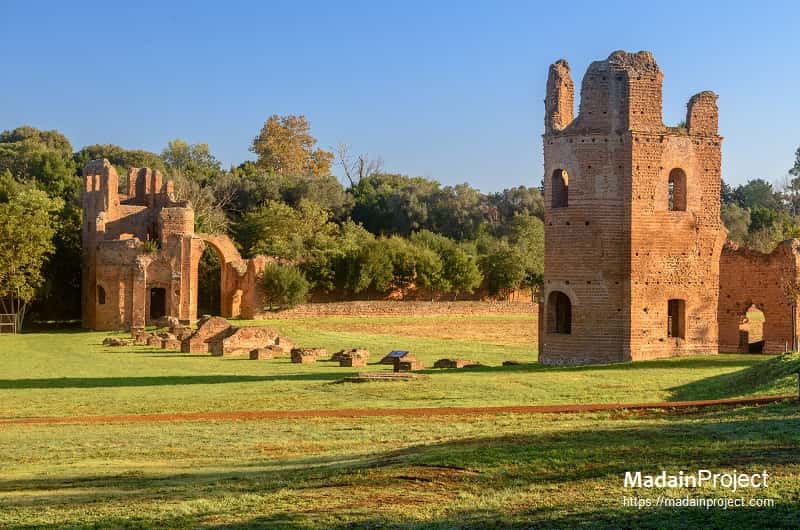
The Circo di Massenzio is one of the better-preserved ancient circuses and is known for its historical significance and architectural features. The Circus of Maxentius was built during the early fourth century CE, during the reign of the Roman Emperor Maxentius. It is one of the last and largest circuses constructed in ancient Rome. Read more

The Pyramid of Cestius (Piramide di Caio Cestio), an ancient pyramid-shaped tomb, it is one of the few surviving examples of pyramidal structures from ancient Rome. Built as a tomb for Gaius Cestius, a Roman magistrate and member of the religious corporation, it was constructed between 18-12 BCE. Read more
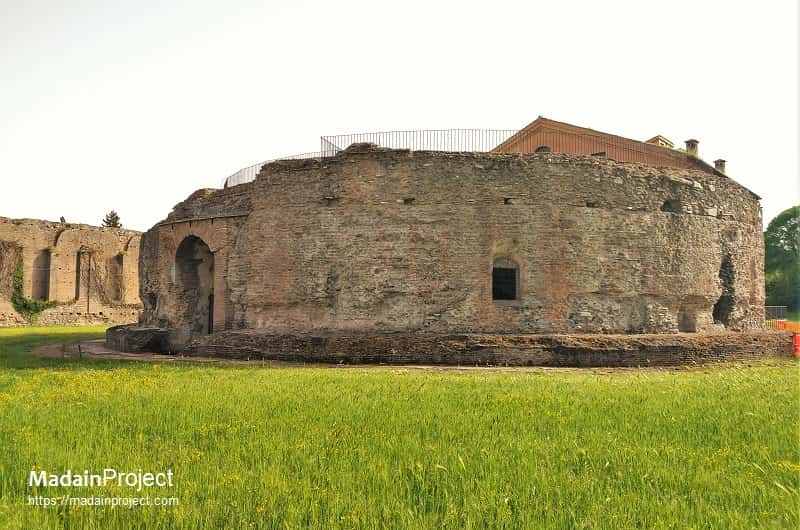
The dynastic mausoleum of emperor Maxentius was built during the early fourth century CE, during the reign of the Roman Emperor Maxentius. He was a prominent figure during the tumultuous period known as the Crisis of the Third Century. The mausoleum is situated outside the city walls of ancient Rome, along the Appian Way (Via Appia Antica). Read more

The Colosseum Archaeological Park, located in Rome, Italy, is a vast and historically rich area encompassing some of the most iconic landmarks of ancient Rome. The centerpiece of the park is the Colosseum, also known as the Flavian Amphitheatre among several other notable monuments. Read more

The Hadrian's Athenaeum (Ateneo di Adriana), founded by the Emperor Hadrian for the promotion of literary and scientific studies (ingenuarum artium) situated near the Capitoline Hill. The Athenaeum seems to have remained in use until the sixth century CE. Read more

The Appian Way (Via Appia Antica) is one of the most famous ancient roads from Rome, originally constructed in 312 BCE by the Roman censor Appius Claudius Caecus. It was an important route for military supplies and communication, connecting Rome to the southern parts of Italy. The original route of the Appian Way started in Rome and ran southeast to the town of Capua. It was later extended to the port of Brindisi, covering a total distance of about 350 miles (563 kilometers). Read more

The Baths of Diocletian, one of the grandest and most ambitious public bath complexes in ancient Rome, were constructed between 298 and 306 CE under the reign of Emperor Diocletian. Designed to accommodate thousands of bathers at once, the complex epitomized Roman engineering prowess and served as a symbol of the emperor's power and generosity. Covering an area of approximately 13 hectares, the baths were not only a place for bathing but also a social hub, with libraries, gymnasiums, and gardens. Read more

The Aventine Hill, known for its green spaces and gardens, is one of the seven hills on which ancient Rome was built. It is situated on the left bank of the Tiber River, across from the Palatine Hill and the Roman Forum. In ancient Rome, the Aventine Hill was not only associated with various legends and historical events but has played a role in the cultural and religious life. Read more

The Forum of Peace, known as the "Forum Pacis" in Latin, was an ancient Roman forum located in Rome. It was also known as the Forum of Vespasian or Temple of Peace. It was built to commemorate the end of the civil wars and the establishment of peace in the Roman Empire. The construction began in 71 CE during the reign of the Roman Emperor Vespasian and was completed by his son Titus. Read more

The Caelian Hill (Celio), is one of the Seven Hills of Rome, which are prominent geographical features in the historic center of Rome. Located southeast of the Roman Forum it runs between the Palatine Hill (another of the Seven Hills) to the west and the Esquiline Hill to the north. Read more

The mausoleum was built during the late Republican period of ancient Rome, around 30-20 BCE. It is named after Caecilia Metella, the daughter of Quintus Caecilius Metellus Creticus, a Roman consul. The Mausoleum of Caecilia Metella is a cylindrical tomb with a large base made of travertine stone. Read more

The Caetani Castle was was developed during the medieval period and constructed incorporatin the ancient Roman funerary monumnets that once stood along the Via Appia Antica. The fortress played a key role in controlling and protecting the surrounding territories. The structure is characterized by a series of defensive walls, towers, and gates, as well as an internal layout that reflects its primary purpose as a military and administrative center in the Roman countryside. Read more
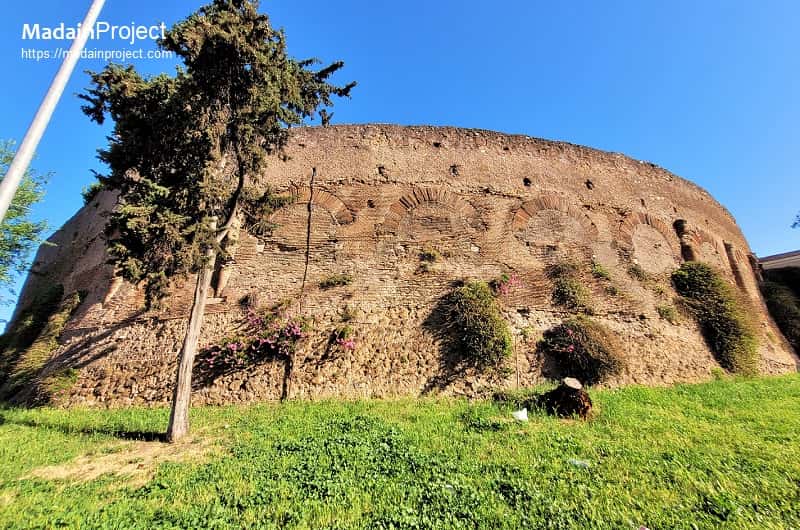
The Castrense Amphitheatre was built during the third century CE, likely in the late Roman Empire. Its construction is attributed to the Emperor Maxentius, who also constructed the nearby Basilica of Maxentius. The amphitheater is situated in the southeastern part of Rome, not far from the Aurelian Walls. Read more
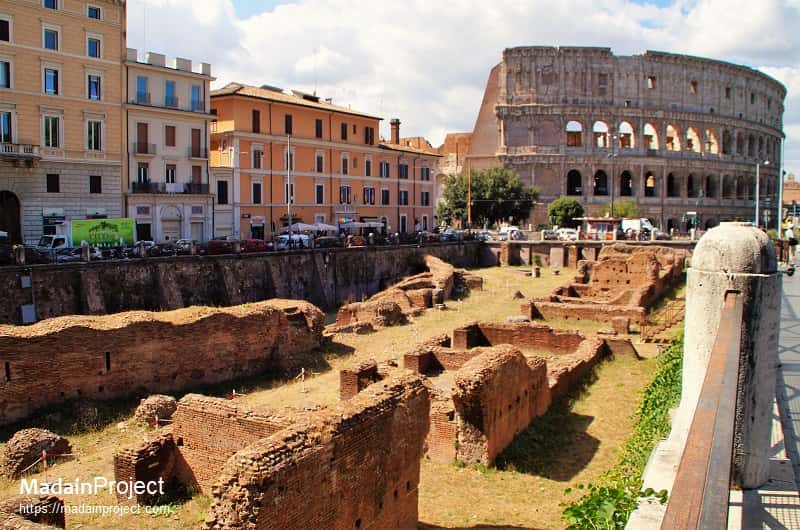
The Ludus Magnus, also known as the "Great Gladiatorial Training School," was an ancient Roman training facility for gladiators located in the ancient city of Rome, near the Colosseo. It was one of several such training schools in ancient Rome where gladiators were prepared for combat in the arenas. Read more

The Porticus Octaviae (Portico of Octavia), located in the Campus Martius area of ancient Rome, was a monumental portico that originally housed temples dedicated to Jupiter Stator and Juno Regina. It was constructed around 27 BCE by Emperor Augustus, who named it in honor of his sister, Octavia Minor. The portico replaced an earlier structure built by Quintus Caecilius Metellus Macedonicus in 146 BCE. Read more

The Flavian Palace (Domus Flavia), commissioned by Emperor Domitian and completed in 92 CE, was a sprawling complex served as the principal residence and administrative center for the Flavian dynasty. Designed by the renowned architect Rabirius, the palace integrated opulent living quarters, grand ceremonial spaces, and state offices, blending luxury with functionality. Its richly adorned halls, including the Aula Regia and the Basilica, reflect the power and prestige of the Roman emperors. Read more

The Theater of Marcellus, commissioned by Julius Caesar and completed by Augustus in 13 BCE, was dedicated to Marcellus, Augustus's nephew and heir apparent, who tragically died young. Located near the Tiber River, it was the largest and most impressive theater of its time, capable of accommodating approximately 15,000 spectators. The theater hosted a variety of performances, including plays, concerts, and recitations, embodying the Roman dedication to public entertainment and civic pride. Read more

The Horti Farnesiani nymphaeum, located on the slopes of the Palatine Hill near the Domus Tiberiana, is a semi-circular grotto-like structure characterized by its elaborate water features and decorative elements. The nymphaeum derives its name from niches in the walls that once housed statues of satyrs holding mirrors. Its architectural design incorporates a mosaic-encrusted vaulted ceiling from which water cascaded like rain, along with streams flowing from the bases of niches and concealed holes in the floor. This integration of flowing water, colored stones, and statuary exemplifies the Roman synthesis of art, nature, and engineering, creating a space for leisure and aesthetic enjoyment. Read more

The Arch of Septimius Severus, erected in 203 CE in the Roman Forum, stands as a monumental symbol of imperial power and military triumph. Commissioned by the Senate to commemorate Emperor Septimius Severus’ victorious campaigns in Parthia, this triumphal arch is one of the most important surviving structures from the Severan dynasty. Distinguished by its detailed reliefs and grand design, the arch not only celebrates the emperor’s military successes but also reinforces his authority and legitimacy. Read more

The Temple of Vesta, located in the Roman Forum, was one of the most sacred and important religious sites in ancient Rome. Dedicated to Vesta, the goddess of the hearth, home, and family, the temple housed the eternal flame that symbolized the continuity and prosperity of Rome. The structure itself was circular, reflecting the sanctity and eternity of the flame it protected, and was surrounded by a colonnade of 20 Corinthian columns. The Temple of Vesta was not only a religious center but also a symbol of Roman civic identity, as it was closely tied to the Vestal Virgins, a group of priestesses responsible for maintaining the sacred fire. Read more

The Temple of Venus and Roma, located on the Velian Hill overlooking the Roman Forum, was one of the largest and most significant temples in ancient Rome. Dedicated to two goddesses, Venus Felix, the goddess of love and prosperity, and Roma, the personification of the city of Rome, it was inaugurated in 135 CE under the rule of Emperor Hadrian. The temple was a monumental structure, designed by the emperor himself, and it reflected his vision of blending Roman civic identity with divine favor. Read more

The Curia Julia, located at the northern end of the Roman Forum, was the Senate house of ancient Rome. It was built by Julius Caesar in 44 BCE, replacing an earlier structure, the Curia Hostilia, which had been severely damaged by fire. Caesar’s intention was to create a more grandiose and functional space for the Senate, reflecting his own ambitions and the growing power of the Roman state under his leadership. The building was completed by his successor, Emperor Augustus, in 29 BCE, after Caesar's assassination. Read more

The Via Sacra, or "Sacred Way," was the primary street of ancient Rome, running through the heart of the Roman Forum and connecting several important religious and civic sites. It served as the main thoroughfare for triumphal processions, religious festivals, and the movement of the Roman people through the city. Stretching from the Capitoline Hill to the Colosseum, it was the focal point for public ceremonies, with several of Rome's most significant temples and monuments lining its path, including the Temple of Vesta, the Temple of Saturn, and the Arch of Titus. Read more

The Aqua Claudia, one of the eleven aqueducts that supplied ancient Rome with water, was a monumental engineering achievement commissioned during the reign of Emperor Caligula in 38 CE and completed by his successor, Emperor Claudius, in 52 CE. Spanning approximately 70 kilometers, it transported water from springs near Subiaco in the Anio valley to the heart of Rome. Known for its impressive design and resilience, the Aqua Claudia was constructed using concrete faced with opus reticulatum and opus latericium, showcasing Roman innovation in hydraulic engineering. Read more

Pons Aemilius, or Ponte Emilio (Aemilian Bridge), also known as the Ponte Rotto was a notable bridge spanning the river Tiber. Though only part of the bridge survives today, it is one of ancient Rome’s oldest stone bridges. It originally connected the Forum Boarium with Trastevere. Constructed during the mid-Republican period, the bridge played a crucial role in linking the city’s eastern bank with the bustling regions across the river. Read more

The Forum Holitorium, Foro Olitorio, the ancient Roman vegetable and herb market, was located near the Capitoline Hill, roughly along the eastern edge of what is now the Via del Teatro di Marcello. It was located outside the Carmental Gate in the Campus Martius, crowded between the cattle market (Forum Boarium) and buildings located in the Circus Flaminius. Read more

The Baths of Titus (Thermae Titi) were constructed in 81 CE under Emperor Titus, occupying a portion of the former Domus Aurea of Nero. Located on the Esquiline Hill, this public bath complex was among the earliest imperial baths in Rome, serving as a precursor to later, more extensive thermae like the Baths of Trajan. The design of the baths was influenced by Greek and Roman traditions, integrating open courtyards and vaulted chambers. Read more

The Roman Houses of the Caelian Hill, located beneath the modern Basilica of Saints John and Paul (SS Giovanni e Paolo), represent a fascinating multi-phase residential complex. These houses, known as Case Romane del Celio, include structures dating from the 1st to the 4th century CE, showcasing various transformations over time. Among these is the Hall of the Genies, decorated with depictions of winged figures and garlands, and the Hall of False Marbles, noted for its frescoes imitating fine stonework. Read more

The Via Latina was one of the principal ancient Roman roads, running southeast from Rome through Latium and into Campania. Older than the more famous Via Appia, it followed a natural route through the Alban Hills, avoiding marshy lowlands. The road extended for approximately 200 kilometers, passing through significant towns such as Tibur (modern Tivoli), Casinum (modern Cassino), and Beneventum (modern Benevento), serving as a crucial artery for military movements, trade, and communication. Read more

The Archaeological Park of Celio, located on the Caelian Hill in Rome integrates several elements of historical and archaeological interest, including preserved Roman structures, a newly established Museum of the Forma Urbis, and a curated garden containing epigraphic and architectural materials from late 19th-century excavations. Key architectural features in the park include remains of ancient houses, such as those that once lined the Clivo di Scauro, and other structures showcasing Roman residential architecture. Read more

The Domus Aurea, built by Emperor Nero after the Great Fire of Rome in 64 CE, was an expansive and innovative imperial palace located primarily on the Oppian Hill in Rome. Architecturally revolutionary, it featured a complex combination of concrete construction, lavishly frescoed interiors, and a layout that embraced expansive gardens, artificial lakes, and pavilions. Read more

The Museum of the Forma Urbis Romae, part of the newly established Archaeological Park on the Caelian Hill in Rome, is dedicated to housing the surviving fragments of the Forma Urbis Romae. This monumental marble map, commissioned during the reign of Emperor Septimius Severus (203–211 CE), originally adorned the interior wall of the Temple of Peace. Measuring approximately 18 by 13 meters and engraved on 150 marble slabs, the map detailed Rome's cityscape during that era. Read more

The Baths of Trajan, constructed between 104 and 109 CE under Emperor Trajan, were a monumental public bathing complex located on the southern slopes of the Oppian Hill in Rome. Designed by the renowned architect Apollodorus of Damascus, the baths were built atop the remains of Nero's Domus Aurea, symbolically erasing the excesses of Nero's reign and restoring the area for public use. Read more

Parco degli Acquedotti, spanning over 240 hectares, the park is home to some of the most iconic remains of Roman aqueducts, including the Aqua Claudia, Aqua Felice, and Aqua Marcia. These aqueducts, which once carried water over long distances to supply the ever-expanding city of Rome, stand as a testament to the advanced engineering techniques of the Roman Empire. Today, the Park of the Aqueducts serves not only as a scenic green space for residents and visitors but also as an open-air museum, where the past and present of Rome converge. Read more

The Temple of Hadrian (Templum Divus Hadrianus) in Rome was dedicated to the deified Emperor Hadrian by his successor Antoninus Pius in 145 CE. This monumental structure was situated in the Campus Martius, a central area in the city, and it featured a grand portico that surrounded the temple. While much of the original building has been lost, several remains still stand in the Piazza di Pietra, including eleven marble Corinthian columns, which once supported the temple's peristyle. These columns, standing about 15 meters tall, were part of an elaborate structure that also included detailed relief sculptures depicting Roman provinces and military victories. Read more

The Mithraeum of the Circus Maximus is a significant example of Mithraic worship spaces in Rome, discovered in 1931 during construction work. Situated beneath the exedra of the Domitian-era Circus Maximus, this Mithraeum dates to the 2nd or 3rd century CE. It includes three main chambers: a vestibule, a rectangular central space with benches along the walls for initiates, and a smaller apse at the rear, which likely housed a tauroctony relief (depicting Mithras slaying a bull), a central motif in Mithraic rituals. Read more

The Cloaca Maxima, constructed in the 6th century BCE, is one of Rome's earliest and most impressive engineering projects, originally built to drain marshy land between the Esquiline, Viminal, and Quirinal hills, allowing for the establishment of the Roman Forum. Initially an open canal following a natural stream, its banks were fortified with stone to manage water flow and prevent flooding. Read more

The Esquiline Hill is located northeast of the Roman Forum, near the center of Rome. In ancient Rome, it was known for its residential neighborhoods, gardens, and villas. It was densely populated and featured the residences of both wealthy Romans and common citizens. Read more

The museum was designed by the architects Pietro Ascheri, D. Bernardini and Cesare Pascoletti (1939–1941 CE). Its 59 sections illustrate the history of Roman civilization from its origins to the 4th century CE, with models and reproductions, as well as original material. The premises are shared with a planetarium. Read more

The Catacombs of Callixtus (Catacombe di San Callisto) are most notable for containing the Crypt of the Popes and once contained the tombs of several popes from the 2nd to 4th centuries CE. The Catacomb is believed to have been created by future Pope Callixtus I, then a deacon of Rome, under the direction of Pope Zephyrinus, enlarging pre-existing early Christian hypogea. Callixtus himself was entombed in the Catacomb of Calepodius on the Aurelian Way. The crypt fell into disuse and decay as the relics it contained were translated from the catacombs to the various churches of Rome; the final wave of translations from the crypt occurred under Pope Sergius II in the 9th century CE. Read more

The Arch of Gallienus (Arco di Gallieno) is the modern name of the ancient Esquiline Gate (Porta Esquilina) in the ancient Servian Wall of Rome. It is a late 3rd-century Roman triumphal arch located in Rome, at the site of the ancient Porta Esquilina, an old city gate of the Servian Wall. It was dedicated in 262 CE by a wealthy merchant, Marcus Aurelius Victor, in honor of Emperor Gallienus (r. 253–268 CE) and his wife Salonina. Read more

The so-called temple of Minerva Medca (tempio di Minerva Medica) is a misidentified ancient Roman structure located in the Esquiline district of Rome, dating to the late 3rd or early 4th century CE. Despite its traditional name, the building was not a temple dedicated to Minerva Medica, the goddess of medicine. Instead, it was likely a nymphaeum, a monumental fountain or garden pavilion, possibly connected to the nearby Horti Liciniani, the luxurious gardens of the Licinian imperial family. Read more

The Esquiline Necropolis was one of the largest and most significant burial grounds of ancient Rome, located on the Esquiline Hill. Dating primarily from the early Iron Age through the Republic and early Imperial periods, the necropolis served as the final resting place for individuals from various social strata. Archaeological excavations have uncovered both simple inhumation burials and elaborate cremation tombs, reflecting evolving funerary practices over time. Read more

The Gardens of Maecenas, Horti Maecenatis, constituted the luxurious ancient Roman estate of Gaius Maecenas, an Augustan-era imperial advisor and patron of the arts. The property was among the first in Italy to emulate the style of Persian gardens. The garden complex also included a large nymphaeum, the so-called Maecenas Auditorium, and it excavated in 1874 CE. The residential complex was identified on the Esquiline because of its mention by historian Horace. Read more

The Circus Varianus was an ancient Roman circus located in the eastern part of Rome, near the Sessorium complex and the Amphitheatrum Castrense. It was originally part of the extensive imperial palace complex known as the Palace of the Sessorium, which later became incorporated into the residence of Emperor Elagabalus. The circus was relatively small compared to Rome’s major chariot-racing venues, such as the Circus Maximus, and was likely intended for private imperial use rather than public competitions. Read more

The ancient gateway Porta Esquilina in the Servian Wall provided passage between the city center of ancient Rome and the Esquiline Hill before the city's expansion and construction of the Aurelian Wall. Initially serving as an access point to the Esquiline, which functioned as Rome's cemetery during the Republican period, the area later transformed into a district of luxurious horti, including the Gardens of Maecenas. Read more

Created between 1933 CE and 1937 CE by archaeologist Italo Gismondi, the model is one of the most detailed reconstructions of Imperial Rome ever made. Built at a 1:250 scale, it serves as a fundamental tool for the study of Rome's historic urban topography, capturing the architectural and infrastructural grandeur of the ancient city at its peak. Read more

The magnificent structure is part of that grandiose imperial palace that Elena, mother of Constantine, had built after the victory of Ponte Milvio (312 AD), transforming the residence that belonged a century earlier to the Severan emperors. Of the actual residence remain the hall used as a chapel for the conservation of the Cross, the large apsidal hall subject to the restoration, and conspicuous remains of the domus. Read more
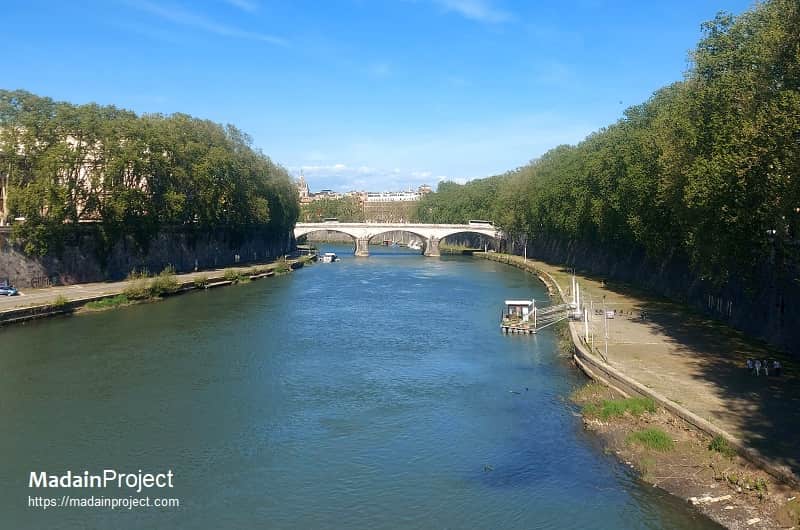
The Tiber has historically defined the geography of Rome and central Italy. It originates in the Apennine range, flows generally southward and westward, and empties into the sea at Ostia. Its basin covers large parts of Tuscany, Umbria, and Lazio. Read more
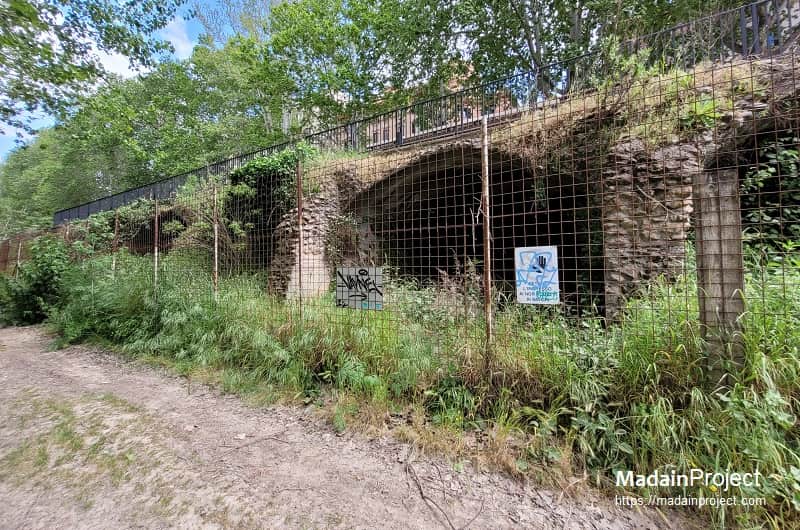
The Emporium was the principal commercial river port of ancient Rome, established in the early 2nd century BCE on the left bank of the river Tiber, immediately south of the Aventine Hill. It was Rome's second urban commercial port, after the first Tiber Port (Portus Tiberinus), functioning as Rome’s central hub for the unloading, storage, and redistribution of bulk goods—particularly grain, wine, olive oil, and building materials—arriving from Ostia and other Mediterranean ports. Read more
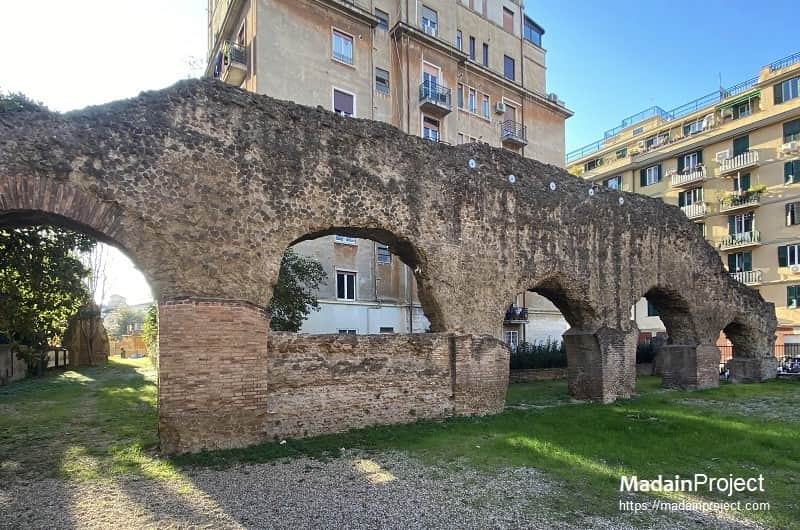
The Porticus Aemilia was a monumental portico-warehouse complex in ancient Rome, constructed in 193 BCE during the consulship of Marcus Aemilius Lepidus and Lucius Aemilius Paullus in the Republican period. Read more

Monte Testaccio, also known as Monte dei Cocci, is an artificial mound in Rome composed almost entirely of testae (cocci), fragments of broken ancient Roman pottery, nearly all discarded amphorae dating from early to the mid of the Roman Empire period, some of which were labelled with tituli picti. Read more

The Trevi Fountain, situated at the junction of Via delle Muratte, Via Poli, and Via dei Crocicchi in the Trevi district of Rome, Italy, is a historic baroque masterpiece and one of the most iconic monumental fountains in the world. It marks the terminal point of the ancient Acqua Vergine aqueduct, originally constructed in 19 BCE to supply water to the Baths of Agrippa. Designed by Nicola Salvi and completed by Giuseppe Pannini in 1762, the fountain is not only an enduring symbol of Rome’s artistic grandeur but also a focal point of popular tradition, including the famous coin-throwing ritual that promises a return to the Eternal City. Read more
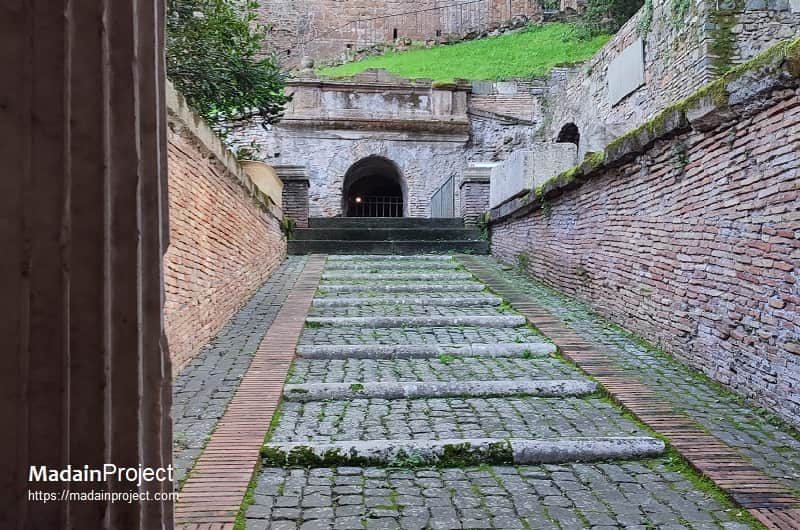
The Tomb of the Scipios (Sepulcro degli Scipioni), a rock-cut subterranean catacomb located along the Via Appia in Rome, served as the principal burial site for the patrician Cornelii Scipiones family from the early 3rd century BCE to the early 1st century CE. The funerary monument is of major importance to academic inquiry for its architectural form, which exhibits Hellenistic influences unusual for Roman funerary practices of the period, as well as for its epigraphic material. Read more
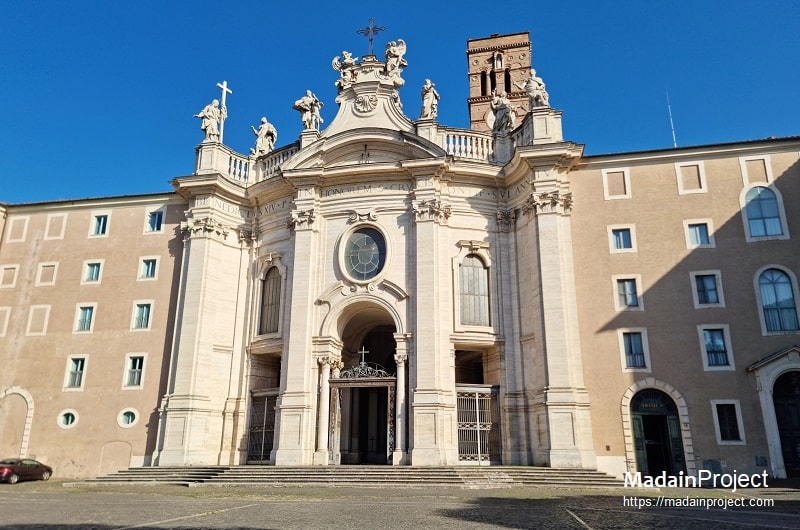
The Basilica of Santa Croce in Gerusalemme, one of the Seven Pilgrim Churches of Rome, is a significant early Christian site known for housing relics of the Passion of Christ. Originally part of the imperial palace complex of Empress Helena, the mother of Constantine the Great, the basilica was constructed in the early 4th century CE. According to tradition, Helena brought soil from Jerusalem and spread it on the floor of the church, giving it the name "Holy Cross in Jerusalem". Read more
Signup for our monthly newsletter / online magazine.
No spam, we promise.
